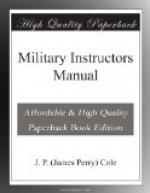space between; an assistant at the other end. On the
instructor’s whistle, the lines advance, guiding carefully
on their leaders. When about ten paces apart, they charge,
each seeking to break and roll up the opposing line.
Sticks are carried and used as rifles with bayonets fixed.
Any other use disqualifies. Use of the butt is barred. One
thrust on the plastron or mask, or two hits on the
extremities, disables the recipient, who must promptly
retire—or be retired. The combat continues until the
second whistle, blown not more than 30 seconds after
contact; when they cease fighting promptly, separate, and
form as before.
c. Criticism:
After each combat, the instructor will criticize the manner
of advance and of fighting, especially the alignment kept
in the advance and the team work in combat, and the
advantage taken of opponents’ mistakes. He counts the
casualties and awards the decision. He must continually
urge the men never to lag behind nor advance ahead of the
line, never to allow large gaps to occur in the line, and
always to seize the advantage given by opponents who
disregard these principles.
d. The terrain for this exercise should be frequently varied.
It may also be conducted at night, the opposing sides
being clearly distinguished.[Q]
[Footnote Q: The last exercise was devised and perfected by M. Jules Leslabay, Master of Fencing, Harvard R.O.T.C., 1917. It is more completely described in his “Manual of Bayonet Training.”]
Machine Guns.
1. Properties of the machine guns are divided into three general classes: Mode of action, fire, and inconspicuousness.
(a) THE MODE OF ACTION.—The
machine gun acting only by its fire
can prepare an
attack or repulse an offensive movement, but it
does not conquer
ground. The latter role is almost exclusively
that of infantry
which is fitted for crossing all obstacles.
When it will suffice
to act by fire, employ the machine gun in
preference to
infantry, preserving the latter for the combined
action of movement
and fire. By the employment of the machine
gun economize
infantry, reserving a more considerable portion
of it for manoeuvre
purposes.
(b) FIRE.—Machine gun
fire produces a sheath, dense, deep but
narrow. The
increase of the width of the sweeping fire gives to
the sheath a greater
breadth, but when the density becomes
insufficient,




